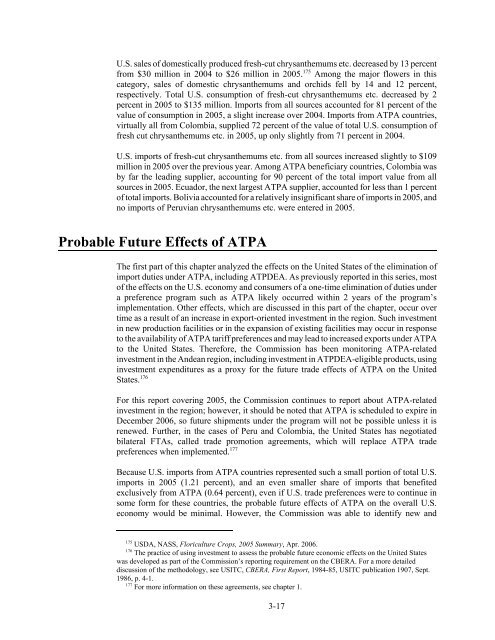The Impact of the Andean Trade Preference Act Twelfth ... - USITC
The Impact of the Andean Trade Preference Act Twelfth ... - USITC
The Impact of the Andean Trade Preference Act Twelfth ... - USITC
- No tags were found...
Create successful ePaper yourself
Turn your PDF publications into a flip-book with our unique Google optimized e-Paper software.
U.S. sales <strong>of</strong> domestically produced fresh-cut chrysan<strong>the</strong>mums etc. decreased by 13 percentfrom $30 million in 2004 to $26 million in 2005. 175 Among <strong>the</strong> major flowers in thiscategory, sales <strong>of</strong> domestic chrysan<strong>the</strong>mums and orchids fell by 14 and 12 percent,respectively. Total U.S. consumption <strong>of</strong> fresh-cut chrysan<strong>the</strong>mums etc. decreased by 2percent in 2005 to $135 million. Imports from all sources accounted for 81 percent <strong>of</strong> <strong>the</strong>value <strong>of</strong> consumption in 2005, a slight increase over 2004. Imports from ATPA countries,virtually all from Colombia, supplied 72 percent <strong>of</strong> <strong>the</strong> value <strong>of</strong> total U.S. consumption <strong>of</strong>fresh cut chrysan<strong>the</strong>mums etc. in 2005, up only slightly from 71 percent in 2004.U.S. imports <strong>of</strong> fresh-cut chrysan<strong>the</strong>mums etc. from all sources increased slightly to $109million in 2005 over <strong>the</strong> previous year. Among ATPA beneficiary countries, Colombia wasby far <strong>the</strong> leading supplier, accounting for 90 percent <strong>of</strong> <strong>the</strong> total import value from allsources in 2005. Ecuador, <strong>the</strong> next largest ATPA supplier, accounted for less than 1 percent<strong>of</strong> total imports. Bolivia accounted for a relatively insignificant share <strong>of</strong> imports in 2005, andno imports <strong>of</strong> Peruvian chrysan<strong>the</strong>mums etc. were entered in 2005.Probable Future Effects <strong>of</strong> ATPA<strong>The</strong> first part <strong>of</strong> this chapter analyzed <strong>the</strong> effects on <strong>the</strong> United States <strong>of</strong> <strong>the</strong> elimination <strong>of</strong>import duties under ATPA, including ATPDEA. As previously reported in this series, most<strong>of</strong> <strong>the</strong> effects on <strong>the</strong> U.S. economy and consumers <strong>of</strong> a one-time elimination <strong>of</strong> duties undera preference program such as ATPA likely occurred within 2 years <strong>of</strong> <strong>the</strong> program’simplementation. O<strong>the</strong>r effects, which are discussed in this part <strong>of</strong> <strong>the</strong> chapter, occur overtime as a result <strong>of</strong> an increase in export-oriented investment in <strong>the</strong> region. Such investmentin new production facilities or in <strong>the</strong> expansion <strong>of</strong> existing facilities may occur in responseto <strong>the</strong> availability <strong>of</strong> ATPA tariff preferences and may lead to increased exports under ATPAto <strong>the</strong> United States. <strong>The</strong>refore, <strong>the</strong> Commission has been monitoring ATPA-relatedinvestment in <strong>the</strong> <strong>Andean</strong> region, including investment in ATPDEA-eligible products, usinginvestment expenditures as a proxy for <strong>the</strong> future trade effects <strong>of</strong> ATPA on <strong>the</strong> UnitedStates. 176For this report covering 2005, <strong>the</strong> Commission continues to report about ATPA-relatedinvestment in <strong>the</strong> region; however, it should be noted that ATPA is scheduled to expire inDecember 2006, so future shipments under <strong>the</strong> program will not be possible unless it isrenewed. Fur<strong>the</strong>r, in <strong>the</strong> cases <strong>of</strong> Peru and Colombia, <strong>the</strong> United States has negotiatedbilateral FTAs, called trade promotion agreements, which will replace ATPA tradepreferences when implemented. 177Because U.S. imports from ATPA countries represented such a small portion <strong>of</strong> total U.S.imports in 2005 (1.21 percent), and an even smaller share <strong>of</strong> imports that benefitedexclusively from ATPA (0.64 percent), even if U.S. trade preferences were to continue insome form for <strong>the</strong>se countries, <strong>the</strong> probable future effects <strong>of</strong> ATPA on <strong>the</strong> overall U.S.economy would be minimal. However, <strong>the</strong> Commission was able to identify new and175 USDA, NASS, Floriculture Crops, 2005 Summary, Apr. 2006.176 <strong>The</strong> practice <strong>of</strong> using investment to assess <strong>the</strong> probable future economic effects on <strong>the</strong> United Stateswas developed as part <strong>of</strong> <strong>the</strong> Commission’s reporting requirement on <strong>the</strong> CBERA. For a more detaileddiscussion <strong>of</strong> <strong>the</strong> methodology, see <strong>USITC</strong>, CBERA, First Report, 1984-85, <strong>USITC</strong> publication 1907, Sept.1986, p. 4-1.177 For more information on <strong>the</strong>se agreements, see chapter 1.3-17
















